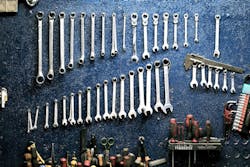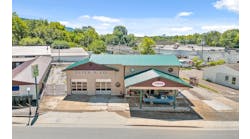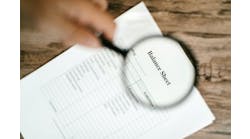Shop Stats: Parkwood Collision Operators: Aaron Weaver, co-owner, Matthew Rinker, co-owner Location: Frisco, Texas Size: 21,000 square feet Staff: 11 in the body shop (1 manager, 2 estimators, 1 parts manager, 4 body techs, 1 detailer/helper, 1 painter, 1 prepper) Average Monthly Car Count: 60 Annual revenue: $1.5 million
In Frisco, Texas, Matt Rinker co-owns a shop that thrives from word-of-mouth referrals from customers. While Rinker entered the automotive industry after working in real estate, his father was a shop operator and let him help around the business.
“Because I don’t come from the body shop industry, I tried to create a different environment for my guys,” Rinker says. “I don’t micromanage.”
Rinker instead spends his days working primarily with his manager. The two of them focus on the financial aspects of the business and quality control issues. Rinker spends his days focused on the shop’s spending and how much money is flowing in and out.
Through steady referrals and word-of-mouth business, Parkwood Collision produced roughly $1.5 million in annual revenue last year.
However, Rinker sees tons of opportunity in the growing area: In the last decade or so, the Dallas Cowboys built a new practice facility in Frisco. After that, more and more auto parks were built in the area. Recently, the town of Frisco was declassified as a rural area and classified as an urban center, changing the business dynamic of the town.
And, Tesla opened a body shop in Dallas, within 25 miles of the Parkwood shop. Rinker saw an opportunity when the shop was not taking larger hits and structural work.
The shop has grown into an operation that not only includes a 21,000 square foot body shop but three facilities in total. And, Rinker has plans to take advantage of the changes in the auto body industry and his town by working on attaining Tesla certifications for the shop.
As told to Melissa Steinken
Usually around 7–7:30 a.m. is when everyone shows up at the shop. We’re open 7 a.m. to 6 p.m. There might be a couple of guys that show up early but we wait until everyone is here to start the morning meeting. Once everyone is here, we have a production meeting and discuss what cars need to go out that week, which cars need parts, quality control, or need mechanical work.
My business partner does reconditioning for Tesla and part of that is what pushed us to become a Tesla-certified shop. My partner has a 9,000-square-foot shop in which he has a private automotive dealership license. He does sales and leasing and when he gets returns, we market those through that business.
Now, we’re fully Tesla certified. In July 2018, we received our formal certification. Since that time, we’ve completed roughly 60 Tesla repair orders. Twenty of those repairs were significant accident repairs, and 30–40 were lighter hits and recalls. Tesla will send us any Model 3 that had delivery issues in which it received a bad paint job, dents or chips in the body. It’s a good deal because not only do we get the extra work, but they’ll give us warranty work, as well.
In the third quarter alone, we did roughly $19,000 worth of Tesla repair work and, in the fourth quarter of 2018, we were up to $90,000 of work.
The new body shop location opened one year ago, in 2018. My partner and I had an established mechanical shop, so, for 10 months prior to opening a physical body shop, we worked out of the back of the mechanical shop. We worked on getting our repair systems in place, and worked on jobs like bumper repairs.
In 2017, we also had a big hail storm, so that brought in a steady stream of business. We took the transition time as a chance to market and form a history of business. Most vendors don’t put you on 30-day credit until you have a two-year history of business.
A big part of my day is spent on our customer service. I take time to walk around the car with the customer and discuss thing like repair versus replace on parts.
I also sit at a counter with my estimators and managers. I sit next to my manager so that if anyone, either an employee or a customer, has an issue, we can all discuss it in the open. My manager and I are more worried about the big picture numbers, inventory and finance of the business. I try not to micromanage my team.
Often, during the week, I’ll go to training classes for a couple hours or send my staff to training. When, I first started, I got my painter certification, color certification and trained in the different departments of the shop. Now, I continue to take time out of the day and week to devote to keeping up with my training. One benchmark for us is to reach I-CAR Gold status in 2019.
I like the procedures in the shop to be transparent. For example, if a person needs to scan out a tool or part from the parts room, then he or she will scan his or her name, scan out the item and it goes on the RO.
We also have a screen that hangs up in the shop floor. The screen shows the sales for the month and what part of the budget was spent on certain items. If toner or adhesives were bought, then it will show how much came out of the shop’s budget. For example, if we’re at $10,000 and then it goes down to $8,000, I want my team to visually see that. Then the team can conceptualize why we’re not doing complete paints or where money is being invested.
I come from spending time around my dad’s company of 400 employees. While I didn’t grow up in the industry, my dad has always collected cars and he’s somewhat of a “car nut.” I worked around my dad while he quit his old profession of dentistry and went into the automotive business of repairing cars.
I’ve learned you have to care about your employees but also instill honesty. If you break something, then say it. If someone doesn’t care about a certain aspect of the repair, it’s hard to make them care and, in that case, I’ll let someone go if it’s absolutely necessary.
We’re a non-DRP shop, so a large chunk of my day is spent pushing to get jobs. Being a non-DRP shop, we get held up on supplements and adjusters coming to visit the shop. A big part of what we have learned to do to combat this wait is to push on estimates and receiving parts.
We’re a growing business and always continue to grow, if possible.



